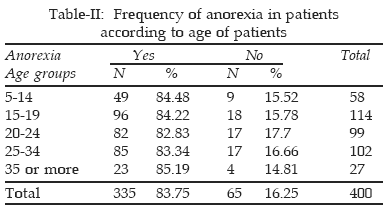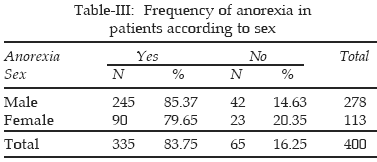|
|
||||
|
Published by : PROFESSIONAL MEDICAL PUBLICATIONS |
||||
|
ISSN 1681-715X |
||||
|
||||
|
- |
||||
|
ORIGINAL ARTICLE |
||||
|
- |
||||
|
Volume 23 |
January - March 2007 |
Number 1 |
||
|
|
||||
|
|
||||
|
|
||||
|
Published by : PROFESSIONAL MEDICAL PUBLICATIONS |
||||
|
ISSN 1681-715X |
||||
|
||||
|
- |
||||
|
ORIGINAL ARTICLE |
||||
|
- |
||||
|
Volume 23 |
January - March 2007 |
Number 1 |
||
|
|
||||
|
|
||||
Diagnostic value of anorexia in acute appendicitis
Ali Akbar Salari1, Fariba Binesh2
ABSTRACT
Background: Acute appendicitis is the most common cause of acute abdominal pain. Early diagnosis and management decrease morbidity and mortality. Diagnosis is usually based on clinical data; history and physical examination. Anorexia is present in almost all cases. In the absence of such symptoms, the probability of the disease decreases.
Objective: This study was designed to determine sensitivity and specificity of anorexia in diagnosis of acute appendicitis.
Methods: All cases of acute abdominal pain admitted in Shahid Rahnemoon and Aafshar hospitals Yazd Iran with primary diagnosis of acute appendicitis during 10 months were evaluated. History of anorexia was recorded and the patients were followed up to determine definite diagnosis by pathology report.
Results: Out of a total of 465 cases, 400 (86%) cases were confirmed of appendicitis. Three hundred thirty five (83.75%) of these patients and 49 (75.34%) of other patients had anorexia (P value =0.09). Sensitivity was 83.75% and specificity was 24.61%. Positive predictive value was 87.2% and Negative predictive value was 19.8%.
Conclusion: Anorexia increases probability of appendicitis but its absence cannot rule out diagnosis of acute appendicitis.
KEY WORDS: Acute appendicitis, Anorexia, Diagnosis.
Pak J Med Sci January - March 2007 Vol. 23 No.1 68-70
1. Dr. Ali Akbar Salari,
Associate Professor of Surgery,
Department of Surgery,
2. Dr. Fariba Binesh,
Assistant Professor of Pathology,
Department of Pathology
1-2: Shahid Sadoughi University of Medical
Sciences
& Health Services Yazd,
Yazd - Iran.
Correspondences
Dr. Ali Akbar Salari,
Email: ali_salari@hotmail.com
* Received for Publication: December 17,
2005
* Accepted: June 21, 2006
INTRODUCTION
Acute appendicitis is one of the commonest surgical emergencies. Simple appendicitis can progress to perforation, which is
associated with a much higher morbidity and mortality, and surgeons have therefore been inclined to operate when the diagnosis is probable rather than wait until it is certain. A clinical decision to operate leads to the removal of a normal appendix in 15% to 30% of cases.1 This proportion may be reduced by observing equivocal cases for a period of time, a practice that seems to be safe for most patients.2 Reductions in the number of "unnecessary" or non-therapeutic operations should not be achieved at the expense of an increase in number of perforations.3 Although nowadays paraclinic services have progressed but they can not be substituted by exact medical examination. Patients history and clinical symptoms especially anorexia have essential role in our diagnosis. The diagnosis of appendicitis should be doubtful when anorexia, nausea or vomiting are absent because anorexia is seen in nearly total patients with acute appendicitis. In this study we decided to consider the frequency of anorexia in acute appendicitis.PATIENTS AND METHODS
In this prospective cross-sectional study, patients who were referred to Shahid Rahnemoon and Afshar hospitals Yazd Iran due to abdominal pain were enrolled. The study period was ten month during 1996-1997.
All these patients had initial examination and paraclinic work-up with proven diagnosis of acute appendicitis. Relevant information was collected through a questionnaire. It included details about patientís sex, age, the place of appendix, having or not having anorexia, nausea, vomiting and appendicitis according to radiological reports. The number of cases according to reliance rate of anorexia was 95% and accuracy of 0.03 were 465 patients. After admission, questionnaire was filled asking patients about their personal characters and order of their symptoms. For examination of anorexia the patients were asked about desire for having specific food that they like while other details were taken from patients laboratory and radiological reports. Chi-square and Z-test in SPSS software was used for statistical evaluation of cases (Š = 0.05).
RESULTS
Four hundred out of 465 patients with acute appendicitis were examined (287 men & 113 women). Of this 83.75% of patients with acute appendicitis had anorexia while 16.25% didnít have, (Table-I)

Again 75.75% of our patients had nausea with anorexia. On the other hand there is significant relationship between anorexia and nausea. (P-value = 0.01) as the same result, 75.04% of them had vomiting with anorexia and after statistical analysis; we found significant relationship between vomiting and anorexia. (P-value = 0.01) as shown in (Table-II & III). There was no significant relationship between age and sex of patients with frequency of anorexia.


DISCUSSION
Acute appendicitis has many clinical symptoms such as anorexia, abdominal pain, nausea, vomiting, urinary symptoms etc. Anorexia is an important and prevalent symptom in acute appendicitis. If a patient has abdominal pain but he or she doesnít have anorexia, the diagnosis of appendicitis becomes doubtful. In this study we found that in patients with acute appendicitis 83.75% had anorexia, so anorexia is an important symptom in this disease.
Pisarra VH believed that the classic sequence of symptoms includes the onset of vague epigastric or periumbilical pain; associated nausea, anorexia, or unsustained vomiting; and pain migrating to the right lower quadrant.
4 Williams NM and his colleagues reported that the onset of pain in the centre of the abdomen and radiation of pain was not sufficient to differentiate between non-specific abdominal pain and acute appendicitis. Progression of pain, nausea, vomiting, anorexia and diarrhea were significantly more common in children with acute appendicitis.5 Rasmussen found that the diagnosis of appendicitis should be in doubt when anorexia, nausea and vomiting are absent.6 According to Horattas MC, appendicitis in the elderly is associated with higher morbidity and mortality. Only 20% of her patients presented classically with anorexia, fever, right lower quadrant pain and an elevated white blood cell count.7 Faloon and his colleagues found out that more than 95% of patients had anorexia.8 It is presumed that this difference is due to social Ė cultural difference of patients.According to Yang HR, Leukocyte count, neutrophil percentage, and C-reactive protein (CRP) have been shown to give valuable information in the diagnosis of acute appendicitis. Patients with normal results in all three tests are highly unlikely to have acute appendicitis and should be evaluated with extra caution before surgery.
9 Khan MN believed that both the inflammatory markers i.e. White Cell Count and C-reactive protein can be helpful in the diagnosis, when measured together as this increases their positive predictive value.10 Wu HP reports that total neutrophil count and C-reactive protein may serve as predictive parameters for early diagnosis of acute appendicitis in children.11 Since anorexia is the most important and prevalent symptoms of acute appendicitis if a patients doesnít have anorexia, the physician should be doubtful about diagnosising acute appendicitis since appendicitis is the most common cause of surgical acute abdomen and it needs early management the physician should examine the patients thoroughly before taking any decision for surgical referral.REFERENCES
1. Hoffmann J, Rasmussen OO. Aids in the diagnosis of acute appendicitis. Br J Surg 1989;76:774-9.
2. Jones PF. Active observation in the management of acute abdominal pain in childhood. BMJ 1976;2:551-3.
3. Velanovich V, Savata R. Balancing the normal appendectomy rate with the perforated appendicitis rate: implications for quality assurance. Am Surg 1992;58:264-9
4. Pisarra VH. Recognizing the various presentations of appendicitis; Nurse Pract 1999;24:44- 49, 54-5.
5. Williams NM, Johnstone JM, Everson NW. The diagnostic value of symptoms and signs in childhood abdominal pain. J R Coll Surg Edinb. 1998;43:390-2.
6. Rasmussen OO, Hoffmann J; Assessment of the reliability of the symptoms and signs of acute appendicitis. J R Coll Surg Edinb. 1991;36:372-7.
7. Horattas MC, Guyton DP, Wu D: A reappraisal of appendicitis in the elderly; Am J Surg. 1990;160:291-3.
8. Fallon WF, Newman JS, Fallon GL. The surgical management of intra-abdominal inflammatory condition during pregnancy. Surg Clin North Am 1995;75:1.
9. Yang HR, Wang YC, Chung PK, Chen WK, Jeng LB, Chen RJ. Role of leukocyte count, neutrophil percentage and C-reactive protein in the diagnosis of acute appendicitis in the elderly. Am Surg. 2005;71:344-7.
10. Khan MN, Davie E, Irshad K. The role of white cell count and C-reactive protein in the diagnosis of acute appendicitis. J Ayub Med Coll Abbottabad. 2004;16:17-19.
11. Wu HP, Chang CF, Lin CY; Predictive inflammatory parameters in the diagnosis of acute appendicitis in children. Acta Paediatr Taiwan. 2003;44:227-31.
HOME | SEARCH | CURRENT ISSUE | PAST ISSUES
Professional
Medical Publications
Room No. 522, 5th Floor, Panorama Centre
Building No. 2, P.O. Box 8766, Saddar, Karachi - Pakistan.
Phones : 5688791, 5689285 Fax : 5689860
pjms@pjms.com.pk